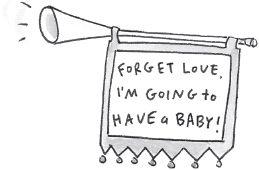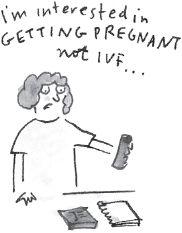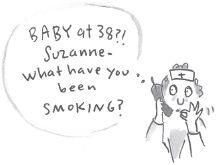One Good Egg: An Illustrated Memoir
Read One Good Egg: An Illustrated Memoir Online
Authors: Suzy Becker


To three great eggs

Contents
What Took Me So Long (The Condensed Version)
If at First Second Third Fourth Fifth Sixth You Don’t Succeed

It’s probably not healthy
wanting desperately to be something you’re not, especially if it’s extinct, but there were plenty of times right up through 2003 when I wished I was a Southern gastric brooding frog. No gastric brooding frog husband to find. No career to worry my shiny frog head. Life could be as simple as swallowing a batch of fertilized eggs and burping up some babies.

For the first twenty-three years of my life, I was sure I’d have babies, at least two. Then it took me fifteen years to decide to go ahead and have just one.

My mother got married and had her first baby in her early twenties. In the decades that followed, the average age of first-time mothers steadily rose; one third of first-time moms are now over the age of thirty. The number of single mothers and the number of women who opted not to have children also rose.
Having options is liberating, except for the parts of you that are tied up in making (and remaking) the decision.

When I was thirty-eight, I finally gave up on finding true love. I had everything else I needed—the career, the home, the friends, the family, and the gumption—to go ahead and have a baby on my own.

In the end, I made my Baby Decision in a half minute on a clear cold February night in 2001 as I stood at the edge of my driveway watching my EX-partner pull out: beagle, belongings, and all.

M
y old gynecologist had left private practice to spend more time with her kids. I took a referral for a new ob-gyn out of the “Baby” folder I kept in the front of my filing cabinet and dialed the number.
“What is this in regard to?”
What this is in regard to would be what this is regarding which is
, “Single parent pregnancy?”
“We don’t do that here.” She gave me the phone number for an IVF clinic and hung up.
IVF clinic?

in vi • tro fer • til • i • za • tion (IVF)
noun
: A procedure in which eggs (
ova
) from a woman’s ovary are removed. They are fertilized with sperm in a laboratory dish, and then the fertilized egg (
embryo
) is returned to the woman’s uterus.
I got another referral and I was connected to a nurse named Mary regarding my interest in “alternative insemination.”
First question: my birth date. “That makes you . . . ”
“Thirty-eight?”
“Thirty-eight?” she paused. “We’ll have to see whether it’s even possible.” Mary’s tone did not ring with possibility. “You’ve been getting regular periods? You’ll need to do Day 3 labs, Day 12 follicle studies. And the father will have to be completely tested; he is a potential liability for us. His sperm needs to be washed and frozen. This is all very expensive and your insurance won’t pay; well, we do have one patient, but—you’ll have to check.”
“I thought the sperm works better if it’s fresh.”
“It does. Now, you’re also going to need a dye test to make sure your tubes are clear. There’s a lot to do, and like I said, it all adds up. Of course we’ll try to keep the costs down; maybe if your day twelves are okay we can skip the day fourteens. Did you want to make an appointment for a consult?”
“Yes, please.”
“And you said you were thirty-eight, right?”
